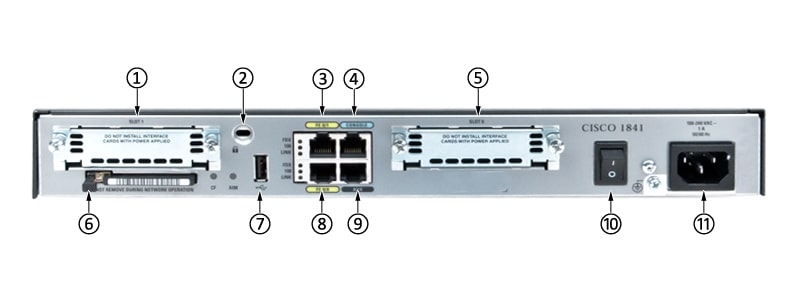Cisco uses the term interface to refer to physical ports on an IOS device. Interfaces can be configured with different settings, depending on the type of the interface and whether you are configuring an interface on a router or a switch. Let’s look at the Cisco 1841 router as an example:
- Slot 1 Network Card expansion slot – you can buy and install an additional interface card of various types to fit in here.
- Kensington Security Slot – you can physical secure the router with a cable here to help prevent theft.
- Fast Ethernet port 0/1 and status indicator LED.
- Console port – you can connect directly to the router’s management command line interface here via your laptop and a console cable.
- Slot 0 Network Card expansion slot – another slot for additional interface cards. Note the the numbering is from right to left.
- CompactFlash memory card slot – the IOS operating system image lives here.
- USB port – You can plug in a USB drive here to move files to and from the router.
- Fast Ethernet port 0/0 and status indicator LED.
- Aux port – You can connect a legacy modem here for out of band (outside the normal network path) management. Not commonly used in modern networks.
- On/Off switch.
- Input power socket.
To display basic information about the device interfaces in IOS, use the show ip interface brief command from the privileged exec mode. This is one of the most commonly used commands on Cisco devices:
Router#sh ip int brief Interface IP-Address OK? Method Status Protocol FastEthernet0/0 192.168.0.1 YES manual administratively down down FastEthernet0/1 unassigned YES unset administratively down down Vlan1 unassigned YES unset administratively down down
In the output above we can see that this router has 2 physical interfaces – FastEthernet0/0 and FastEthernet0/1.
Consider the output for the Fa0/0 interface:
Router#sh ip int brief Interface IP-Address OK? Method Status Protocol FastEthernet0/0 192.168.0.1 YES manual administratively down down
Here is a brief description of each column:
- Interface – displays the type of the interface, in this case Fast Ethernet 0/0. The first zero specifies the physical slot on the router, while the second zero specifies the port number.
- IP-Address – displays the interface’s IP address.
- OK? – YES in this column signifies that the IP address is currently valid.
- Method – manual in this column means that the interface has been manually configured. DHCP means that the interface has been configured using DHCP.
- Status – up indicates that the interface is administratively up.
- Protocol – up indicates that the interface is operational.
To configure a specific interface, use the interface TYPE SLOT/PORT command from the global config mode. This puts us in the interface submode, where we can configure various interface options:
Router(config)#interface f0/0 Router(config-if)#speed 100
In the example above you can see that we’ve configured the speed option for the interface Fast Ethernet 0/0.
By default, all ports on a Cisco switch are up and running as soon as you power-on the device. This means that all you need is to connect your devices and the switch and you are good to go. This isn’t the case with Cisco routers, however. You need to manually enable each interface on a router with the no shutdown interface mode command:
Router(config)#int f0/0 Router(config-if)#no shutdown Router(config-if)# %LINK-5-CHANGED: Interface FastEthernet0/0, changed state to up %LINEPROTO-5-UPDOWN: Line protocol on Interface FastEthernet0/0, changed state to up
Use the show ip interface brief command to check the device’s IP addresses and status of its interfaces:
Router#sh ip int brief Interface IP-Address OK? Method Status Protocol FastEthernet0/0 192.168.0.1 YES manual up up FastEthernet0/1 unassigned YES unset administratively down down Vlan1 unassigned YES unset administratively down down
Download our Free CCNA Study Guide PDF for complete notes on all the CCNA 200-301 exam topics in one book.
We recommend the Cisco CCNA Gold Bootcamp as your main CCNA training course. It’s the highest rated Cisco course online with an average rating of 4.8 from over 30,000 public reviews and is the gold standard in CCNA training:

